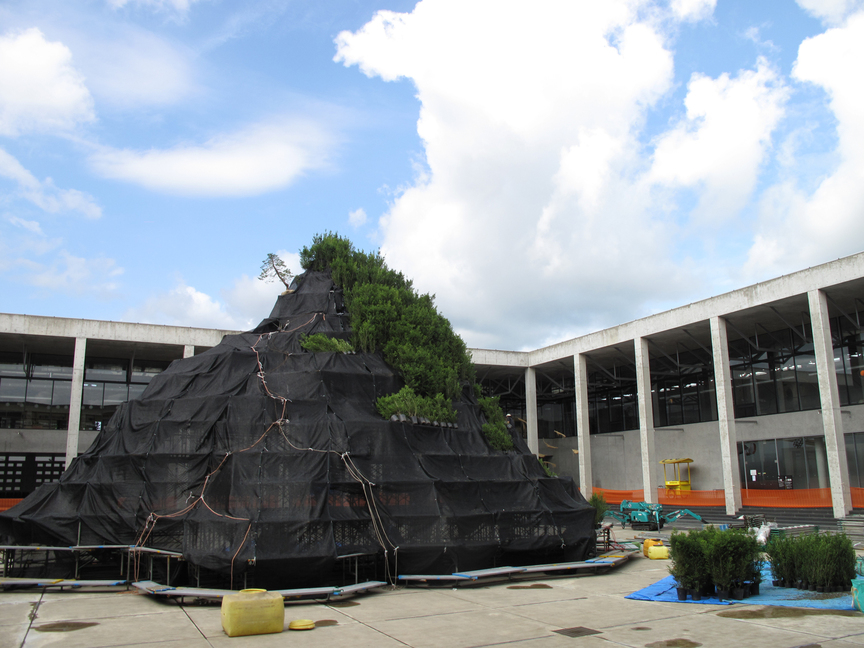The Echigo-Tsumari Satoyama Museum of Contemporary Art,
KINARE serves as a gateway to the Echigo-Tsumari Art Field, where the Triennale is staged.
At the central atrium, CAI GUO-QIANG’s Penglai/Hōrai (2015) is being constructed. The eponymous mountain exists both in Chinese and Japanese myths as very different fairylands. All photos courtesy Angela Lam.
An abandoned primary school serves as the site for the installation Hachi & Seizo Tashima Museum of Picture Book Art (2009).
The “museum” is the work of artist SEIZO TASHIMA, who recreates stories from picture books using driftwood and nuts collected from the shores of the Sea of Japan.
Vegetation grows out of a soil pile randomly placed in a classroom within the festival—a concrete evidence of nature living among the people at Echigo-Tsumari.
Since its creation in 2000, ILYA and EMILIA KABAKOV’s The Rice Field has been a signature installation at the Triennale. Situated on stepped rice fields, yellow and blue sculptures portray actions of farmers practicing intensive farming. Returning to Echigo-Tsumari this year, the artist-duo will create a new work, entitled Arch of Life (2015), which represents life’s inevitable cycle from birth to death.
Part of Matsudai Nobutai, a building designed by the Netherlands’
MVRDV, is raised three meters from the ground to avoid that section of the structure from becoming buried under thick layers of accumulated snow in the winter, and to provide a shaded podium in the summer. Additionally, a small rice field nearby, located next to Shibumi River, will gradually become part of a larger park.
During the Triennale, about 40 artworks will be displayed within and outside the Nobutai building, including Tsumari in Bloom (2003) by YAYOI KUSAMA.
A very proud Hong Kong farmer came for an agricultural exchange and to plant crops for “Ho Mei! Hong Kong: Cooking Demonstration” (7/26–8/30), an ETAT program that will explore Cantonese cuisine cooked with Japanese ingredients, co-hosted by Hong Kong-based social-conscious art group SENSE ART STUDIO.
Shedding House (2006–15), one of the “live-in art” installations of the festival, is a project by JUNICHI KURAKAKE and the Nihon University College of Art Sculpture Course. A reported 3,000 art students took part in carving every surface of a traditional Japanese minka house, under the existentialist idea of “leaving a mark” on a historical object.
RYO TOYOFUKU discussing his work Golden Playroom (2015), a kitsch-adorned room where viewers can play mahjong.
The Last Class (2006/2009), by French artists
CHRISTIAN BOLTANSKI and
JEAN KALMAN, occupies three stories of yet another abandoned primary school.
Their minimalistic installations use fans, acrylic tables, white fabric and school furniture, and the presence of these found and disused everyday objects highlights the absence of living human beings.
A strong spotlight behind a slowly moving fan casts a spinning projection of light and shadow in the long, dark corridor of The Last Class. The work sets the scene like that of a haunted mansion.
Dream House (2000), by performance art doyenne MARINA ABRAMOVIĆ, is one of the first artworks of the Triennale, from its inaugural edition. Having survived massive earthquakes in 2004 and 2011, the “live-in” artwork welcomes guests to stay in it overnight to experience and record their dreams.
Mole Walkway (2015), by TAKUTO HIKI and TAKUMI HONDA, is seen here in the middle of its installation process in the “Soil Museum” (housed in another abandoned school), which is curated by Motoki Sakai. For Hiki and Honda’s work, a soil fence will be constructed using the traditional Japanese method of building neribei (daub wall), which can be found as part of the structure of the world heritage site Himeji Castle.
KATSUHITO NAKAZATO is showing one of his unframed photographic works from the “MABU–Boundary of Light” series (2015), which features scenes from hand-dug underground canals. Strong in light and shadow, the series explores the beauty of nature in human-created environments.
KAORI SATO’s mural, Road to Atoms (2015), is painted with different colors of soil found in the Fukushima Prefecture, a gesture that pays tribute to the Tōhoku Earthquake in 2011.
Seen here is Taiwanese artist LIN SHUEN-LONG’s Beyond Borders (2009), a free-standing wall drawn on with Chinese mythical stories. Nearby, Lin will create a new edition of the work, entitled Beyond the Borders: Mountain(2015), which will be a stage referencing a Japanese house built in a cedar forest.
The Voyage Beyond Time (2009) is a work by Chinese installation artist GUAN HUAIBIN. Situated next to a playground, the rustic, maze-like structure is fitted with spinning mirrors, literally reflecting the peaceful surroundings of nature.
Seen here is the house where Hong Kong ceramicist
FIONA WONG will create
Gogasha (2015), a restoration of a small hut that had originally been built for children, but had become abandoned over the course of 30 years.
Inspired by the Japanese literary classic “In Praise of Shadows” by Junichiro Tanizaki, Wong will be hanging on site translucent porcelain sculptures that change color during the day.
British artist RICHARD WILSON’s Set North for Japan (74°33’2”) (2000) is a full-scale model of the frame of his London house, placed upside down in front of a functioning primary school.
For Lots of Lost Windows (2006) is the melancholic name of AKIKO UTSUMI’s minimalist installation. The “window” seen here helps the experience of viewing the natural landscape of the region without disturbing its serenity.




